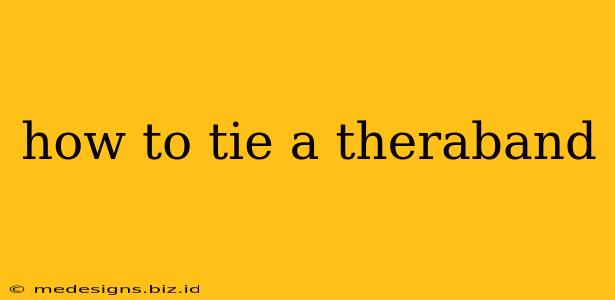How to Tie a Theraband: A Comprehensive Guide for Beginners and Beyond
Therabands are fantastic tools for physical therapy, rehabilitation, and fitness. But before you can start reaping the benefits, you need to know how to tie them securely and effectively. This guide will walk you through various methods, catering to different needs and band types.
Why Proper Theraband Tying Matters:
Improperly tied therabands can lead to several issues:
- Injury: A loose or poorly tied band can snap unexpectedly, causing injury.
- Ineffective workouts: A band that slips or loosens compromises the resistance and effectiveness of your exercises.
- Frustration: Constantly readjusting your band wastes time and disrupts your workout flow.
Methods for Tying a Theraband:
We'll cover three common and reliable methods:
1. The Simple Overhand Knot:
This method is best for lighter resistance bands and situations where you need a quick and easy tie.
-
Steps:
- Hold one end of the theraband in each hand.
- Make a simple overhand knot, just like you would tie your shoelaces.
- Pull the knot tight to ensure it's secure.
-
Pros: Simple, fast.
-
Cons: Not ideal for heavier resistance bands or intense workouts; prone to loosening over time.
2. The Double Overhand Knot:
This is a more secure option, suitable for medium resistance bands and most common workout scenarios.
-
Steps:
- Hold one end of the theraband in each hand.
- Tie a simple overhand knot.
- Tie another overhand knot directly on top of the first.
- Pull both knots tight.
-
Pros: More secure than a single overhand knot; suitable for most exercises.
-
Cons: Might still loosen with heavy use; takes slightly longer to tie.
3. The Figure-Eight Knot:
This method provides the strongest and most secure tie, perfect for heavy resistance bands and high-intensity workouts. It's slightly more complex but well worth the extra effort for safety and reliability.
-
Steps:
- Hold one end of the theraband in each hand.
- Cross one end over the other, creating an "X."
- Bring the crossed end under and through the loop formed by the "X," creating a figure-eight shape.
- Pull both ends tight.
-
Pros: Extremely secure, less likely to come undone; ideal for heavy bands and intense training.
-
Cons: Takes slightly longer to tie; requires slightly more dexterity.
Choosing the Right Method:
The best method depends on several factors:
- Theraband Resistance: Heavier bands require more secure knots.
- Exercise Intensity: High-intensity workouts necessitate a strong and reliable knot.
- Personal Preference: Once you've mastered all three, choose the method you find easiest and most reliable.
Beyond the Knot: Anchoring Your Theraband
Once your theraband is tied, you need to anchor it securely. This can be achieved using various methods depending on your exercise and environment. Common anchoring points include:
- Door Anchors: Specifically designed door anchors prevent damage to your doors.
- Furniture: Sturdy furniture legs can serve as anchors, but ensure they are stable and won’t be damaged.
- Weight Machines: Some weight machines have attachments for resistance bands.
Remember always to prioritize safety. If you're unsure about any tying method or anchoring technique, consult a physical therapist or fitness professional. Properly tying your theraband is crucial for a safe and effective workout.
